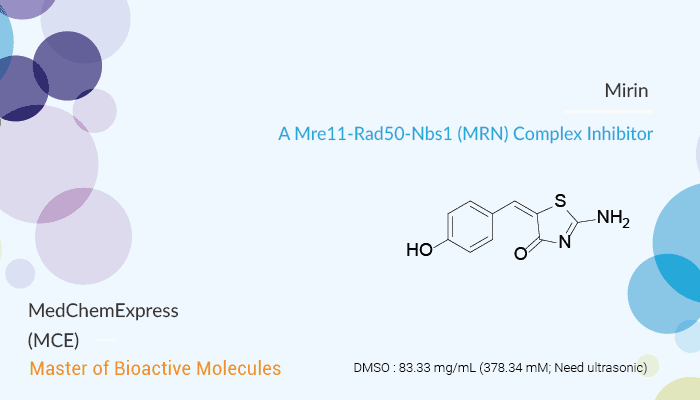ATM belongs to the phosphatidylinositol-3′ kinase-related kinase (PIKK) family. It has a critical role in the maintenance of genome integrity. In response to agents that generate DNA double-strand breaks (DSBs), inactive dimeric ATM protein dissociates into phosphorylated monomers. The MRN (Mre11-Rad50-Nbs1)-ATM pathway is essential for sensing and signaling from DNA double-strand breaks. The MRN complex recruits ATM to damaged DNA. Upon activation, ATM phosphorylates several substrates, including p53, Chk2, Nbs1, and BRCA1. So, they together coordinate cell cycle arrest and DNA repair. In a word, the MRN complex acts as a DNA damage sensor. It maintains genome stability during DNA replication, promotes homology-dependent DNA repair, and activates ATM. In this study, Mirin is an inhibitor of MRN. This inhibitor prevents ATM activation in response to DSBs and blocks homology-directed repair (HDR) in mammalian cells.

Mirin prevents MRN-dependent activation of ATM (IC50=12 μM) without affecting ATM protein kinase activity, it also inhibits Mre11-associated exonuclease activity. Mirin abolishes the G2/M checkpoint and homology-dependent repair in mammalian cells. It prevents ATM activation in response to DSBs and blocks homology-directed repair (HDR) in mammalian cells. It also inhibits H2AX phosphorylation with an IC50 of 66 μM. In addition, it also inhibits the ATM-dependent phosphorylation of the downstream targets Nbs1 and Chk2 and the MRN-dependent autophosphorylation of ATM at Ser1981 in response to DSBs. Moreover, Mirin induces a substantial G2 arrest at concentrations of 50 μM and 100 μM. Mirin (10-100 μM) inhibits homology-dependent DNA repair in TOSA4 cells.
In summary, Mirin is a potent MRN complex inhibitor.
Reference:
Dupré A, et al. Nat Chem Biol. 2008;4(2):119-125.